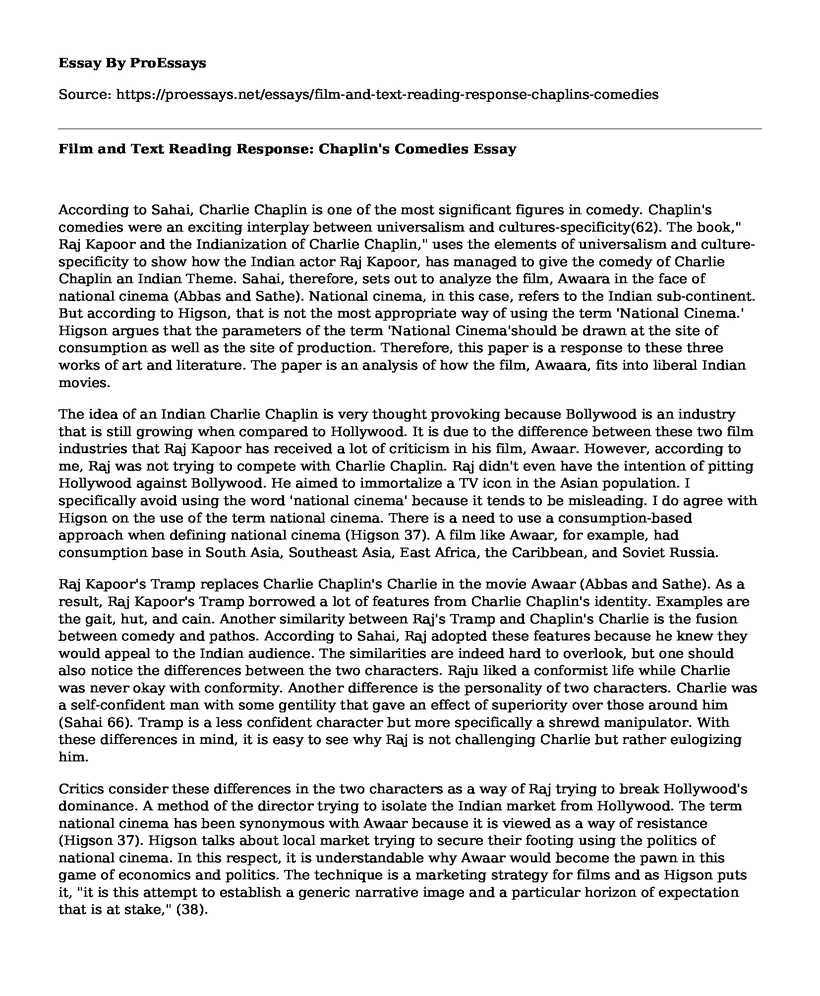According to Sahai, Charlie Chaplin is one of the most significant figures in comedy. Chaplin's comedies were an exciting interplay between universalism and cultures-specificity(62). The book," Raj Kapoor and the Indianization of Charlie Chaplin," uses the elements of universalism and culture-specificity to show how the Indian actor Raj Kapoor, has managed to give the comedy of Charlie Chaplin an Indian Theme. Sahai, therefore, sets out to analyze the film, Awaara in the face of national cinema (Abbas and Sathe). National cinema, in this case, refers to the Indian sub-continent. But according to Higson, that is not the most appropriate way of using the term 'National Cinema.' Higson argues that the parameters of the term 'National Cinema'should be drawn at the site of consumption as well as the site of production. Therefore, this paper is a response to these three works of art and literature. The paper is an analysis of how the film, Awaara, fits into liberal Indian movies.
The idea of an Indian Charlie Chaplin is very thought provoking because Bollywood is an industry that is still growing when compared to Hollywood. It is due to the difference between these two film industries that Raj Kapoor has received a lot of criticism in his film, Awaar. However, according to me, Raj was not trying to compete with Charlie Chaplin. Raj didn't even have the intention of pitting Hollywood against Bollywood. He aimed to immortalize a TV icon in the Asian population. I specifically avoid using the word 'national cinema' because it tends to be misleading. I do agree with Higson on the use of the term national cinema. There is a need to use a consumption-based approach when defining national cinema (Higson 37). A film like Awaar, for example, had consumption base in South Asia, Southeast Asia, East Africa, the Caribbean, and Soviet Russia.
Raj Kapoor's Tramp replaces Charlie Chaplin's Charlie in the movie Awaar (Abbas and Sathe). As a result, Raj Kapoor's Tramp borrowed a lot of features from Charlie Chaplin's identity. Examples are the gait, hut, and cain. Another similarity between Raj's Tramp and Chaplin's Charlie is the fusion between comedy and pathos. According to Sahai, Raj adopted these features because he knew they would appeal to the Indian audience. The similarities are indeed hard to overlook, but one should also notice the differences between the two characters. Raju liked a conformist life while Charlie was never okay with conformity. Another difference is the personality of two characters. Charlie was a self-confident man with some gentility that gave an effect of superiority over those around him (Sahai 66). Tramp is a less confident character but more specifically a shrewd manipulator. With these differences in mind, it is easy to see why Raj is not challenging Charlie but rather eulogizing him.
Critics consider these differences in the two characters as a way of Raj trying to break Hollywood's dominance. A method of the director trying to isolate the Indian market from Hollywood. The term national cinema has been synonymous with Awaar because it is viewed as a way of resistance (Higson 37). Higson talks about local market trying to secure their footing using the politics of national cinema. In this respect, it is understandable why Awaar would become the pawn in this game of economics and politics. The technique is a marketing strategy for films and as Higson puts it, "it is this attempt to establish a generic narrative image and a particular horizon of expectation that is at stake," (38).
Works Cited
Awaara. By Khwaja Ahmad Abbas and V.P. Sathe. Dir. Raj Kapoor. Perf. Raj Kapoor. Prod. Raj Kapoor. J.H. Hoffberg Company, New Realm Entertainments, Atlantic Video Inc, Esquire (Electronics) Ltd, 1951. Youtube. 28 September 2018. <https://www.youtube.com/watch?v=u4mjCJaJe-g>.
Higson, Andrew. "The Concept of National Cinema." Oxford Journals 30 (1989): 36-46. Print. 28 September 2018.
Sahai, Malti. "Raj Kapoor and the Indianization of Charlie Chaplin." East-West Film Journal 20.1 (1987): 62-75. Print.
Cite this page
Film and Text Reading Response: Chaplin's Comedies. (2022, Aug 15). Retrieved from https://proessays.net/essays/film-and-text-reading-response-chaplins-comedies
If you are the original author of this essay and no longer wish to have it published on the ProEssays website, please click below to request its removal:
- Effect of Social Media on Business in the UAE - Essay Example
- American TV Programs Imaging of Arabs as Terrorists and Villains
- Essay on Love and War Unite in Leonato's Home: Claudio and Hero's Romance
- Organizational Success Through Social Media Tools - Essay Sample
- The Golden Age of Japanese Cinema: 1950s Post-War Prosperity - Research Paper
- Essay Example on Monster Soundtracks: Music in Film Since 1800s
- Caravaggio: Pioneering Artist of Intense Passion and Controversy - Essay Sample







